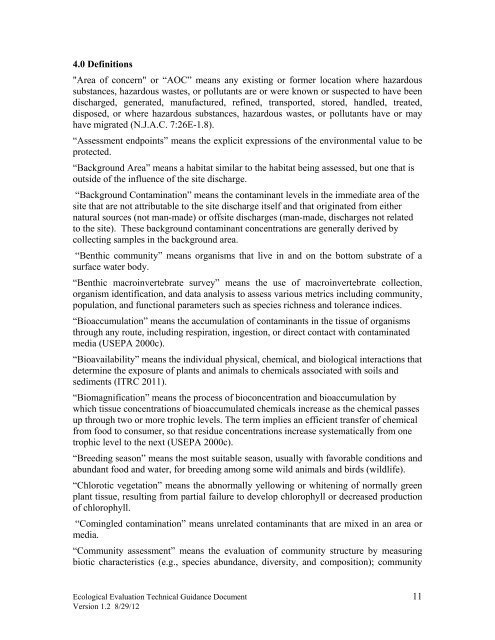Ecological Evaluation Technical Guidance - State of New Jersey
Ecological Evaluation Technical Guidance - State of New Jersey
Ecological Evaluation Technical Guidance - State of New Jersey
- No tags were found...
Create successful ePaper yourself
Turn your PDF publications into a flip-book with our unique Google optimized e-Paper software.
4.0 Definitions"Area <strong>of</strong> concern" or “AOC” means any existing or former location where hazardoussubstances, hazardous wastes, or pollutants are or were known or suspected to have beendischarged, generated, manufactured, refined, transported, stored, handled, treated,disposed, or where hazardous substances, hazardous wastes, or pollutants have or mayhave migrated (N.J.A.C. 7:26E-1.8).“Assessment endpoints” means the explicit expressions <strong>of</strong> the environmental value to beprotected.“Background Area” means a habitat similar to the habitat being assessed, but one that isoutside <strong>of</strong> the influence <strong>of</strong> the site discharge.“Background Contamination” means the contaminant levels in the immediate area <strong>of</strong> thesite that are not attributable to the site discharge itself and that originated from eithernatural sources (not man-made) or <strong>of</strong>fsite discharges (man-made, discharges not relatedto the site). These background contaminant concentrations are generally derived bycollecting samples in the background area.“Benthic community” means organisms that live in and on the bottom substrate <strong>of</strong> asurface water body.“Benthic macroinvertebrate survey” means the use <strong>of</strong> macroinvertebrate collection,organism identification, and data analysis to assess various metrics including community,population, and functional parameters such as species richness and tolerance indices.“Bioaccumulation” means the accumulation <strong>of</strong> contaminants in the tissue <strong>of</strong> organismsthrough any route, including respiration, ingestion, or direct contact with contaminatedmedia (USEPA 2000c).“Bioavailability” means the individual physical, chemical, and biological interactions thatdetermine the exposure <strong>of</strong> plants and animals to chemicals associated with soils andsediments (ITRC 2011).“Biomagnification” means the process <strong>of</strong> bioconcentration and bioaccumulation bywhich tissue concentrations <strong>of</strong> bioaccumulated chemicals increase as the chemical passesup through two or more trophic levels. The term implies an efficient transfer <strong>of</strong> chemicalfrom food to consumer, so that residue concentrations increase systematically from onetrophic level to the next (USEPA 2000c).“Breeding season” means the most suitable season, usually with favorable conditions andabundant food and water, for breeding among some wild animals and birds (wildlife).“Chlorotic vegetation” means the abnormally yellowing or whitening <strong>of</strong> normally greenplant tissue, resulting from partial failure to develop chlorophyll or decreased production<strong>of</strong> chlorophyll.“Comingled contamination” means unrelated contaminants that are mixed in an area ormedia.“Community assessment” means the evaluation <strong>of</strong> community structure by measuringbiotic characteristics (e.g., species abundance, diversity, and composition); community<strong>Ecological</strong> <strong>Evaluation</strong> <strong>Technical</strong> <strong>Guidance</strong> Document 11Version 1.2 8/29/12
















